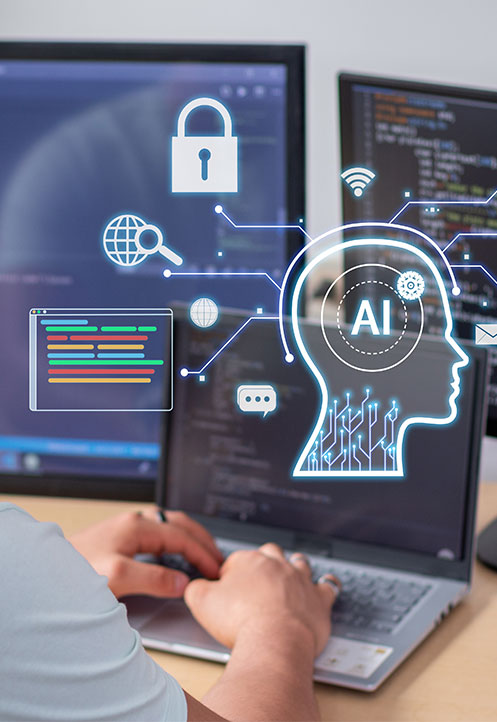Artificial Intelligence (AI) is rapidly becoming a transformative force and differentiator across industries. Whether you’re developing software for business, healthcare, finance, entertainment, or virtually any other use, integrating AI into your project can elevate its capabilities, user experience, and overall success.
Understanding AI’s Impact
AI isn’t just a buzzword; it’s a monumental change in how we approach problem-solving and decision-making within software development. Its ability to analyze vast datasets, recognize patterns, and make predictions is unparalleled. By leveraging machine learning, natural language processing, computer vision, and other AI subsets, software products can automate tasks, personalize user experiences, and provide actionable insights.
Where to Start
The first step in integrating AI into your software product is to identify areas where it can add value. For example:
- Is there a repetitive task that can be automated?
- Can user interactions be enhanced through personalization?
- Could predictive analytics improve decision-making?
By pinpointing these opportunities, you can tailor AI solutions to meet specific needs, maximizing its impact.
Choosing the Right AI Technology
Selecting the appropriate AI technology is crucial. Your decisions can significantly impact the performance and success of your software project. Here are some tips to help you through the selection process:
- Have a well-defined set of objectives or goals.
- Thoroughly understand the problem you are trying to solve; different AI technologies excel in various use cases.
- Assess the available data (see below), including the quality, quantity and diversity of your data.
- Consider computing power and resources needed for a successful implementation.
- Explore pre-built solutions and APIs that can save development time.
- Evaluate frameworks and libraries that make it easier to develop and deploy ML models.
- Choose technologies with strong community support.
- Look to the future and ensure the technology you choose can scale as your product grows.
- Evaluate models and industry requirements, for example transparent models that are critical to compliance and building user trust.
- Remember you are making a long-term commitment to monitoring, maintaining and updating the models to keep them relevant and effective.
- Prioritize AI technologies that align with ethical considerations and privacy standards.
- Seek expert advice to ensure you are making informed decisions.
It’s All About the Data
Quality and diversity of data form the cornerstone for developing AI models that truly reflect the complexity of the world they are meant to interact with and understand.
Clean data ensures that the models are trained on accurate and representative information, reducing the risk of introducing biases or inaccuracies.
Diverse data is also critical as it allows AI models to encounter a broad spectrum of scenarios and variations, enhancing their adaptability to real-world situations. A lack of diversity may result in models that are too narrow in their understanding, limiting their applicability and generalization.
Clean, diverse data improves the robustness and accuracy of AI models and fosters trust and transparency, crucial factors in gaining user acceptance and compliance with ethical standards.

Cooperation between AI and Humans
AI isn’t a replacement for humans; it’s a powerful tool that augments human capabilities. Encourage collaboration between AI specialists, developers, domain experts, and end-users. Their collective insights can lead to more effective AI implementations that truly address user needs.
Iterative Development and Continuous Learning
Developers and development organizations must recognize the dynamic nature of AI. There is no start/stop button; AI requires a continuous investment from the business, and thus a continuous approach from development. In order to harness the power of AI as the model becomes stronger and learns, developers and DevOps must embrace an iterative approach.
In this manner, developers can adapt to evolving requirements, fine-tune AI models based on user feedback, and address emerging challenges.
At the same time, continuous learning highlights the need for AI models to evolve over time as they gain insights from new data and user interactions. This continuous learning loop ensures that AI systems remain adaptive and effective, even in dynamic environments.
By monitoring performance metrics, gathering user feedback, and proactively updating algorithms, developers can keep pace with evolving user preferences and industry trends. This iterative and learning-driven approach enhances the overall efficacy of AI-integrated software and positions it as responsive and future-ready.
Overcoming Challenges
Integrating AI isn’t without challenges. Address concerns like algorithm biases, interpretability, and potential job displacement. Mitigate biases through diverse data representation and regular audits. Enhance interpretability to foster trust and understanding. Invest in reskilling and upskilling to prepare the workforce for AI-driven changes.
The Future of AI in Software Products and Development
As AI continues to advance, its role in shaping the landscape of software products will expand exponentially. AI will become an integral component, enhancing software capabilities across diverse industries and use cases. From intelligent automation and personalized user experiences to advanced analytics and predictive functionalities, AI will redefine how software products are conceived, developed, and utilized.
The ability of AI to adapt, learn and evolve will also streamline development processes and drive unprecedented levels of innovation. Intelligent systems will one day seamlessly anticipate user needs, optimize operations and contribute to the creation of even more intuitive, efficient and sophisticated software solutions. Embracing this evolution is not just a technological imperative but a strategic move towards unlocking the full potential of software development.

Conclusion
Incorporating AI into your software product or project isn’t just a technical decision; it’s a strategic move towards innovation and efficiency. By identifying opportunities, choosing the right AI technology, nurturing quality data, fostering collaboration, and embracing continuous improvement, you can harness the power of AI to create impactful and future-ready software solutions.
The journey towards AI integration may be challenging, but the rewards in terms of enhanced functionality, user satisfaction, and business success are worth the investment.






